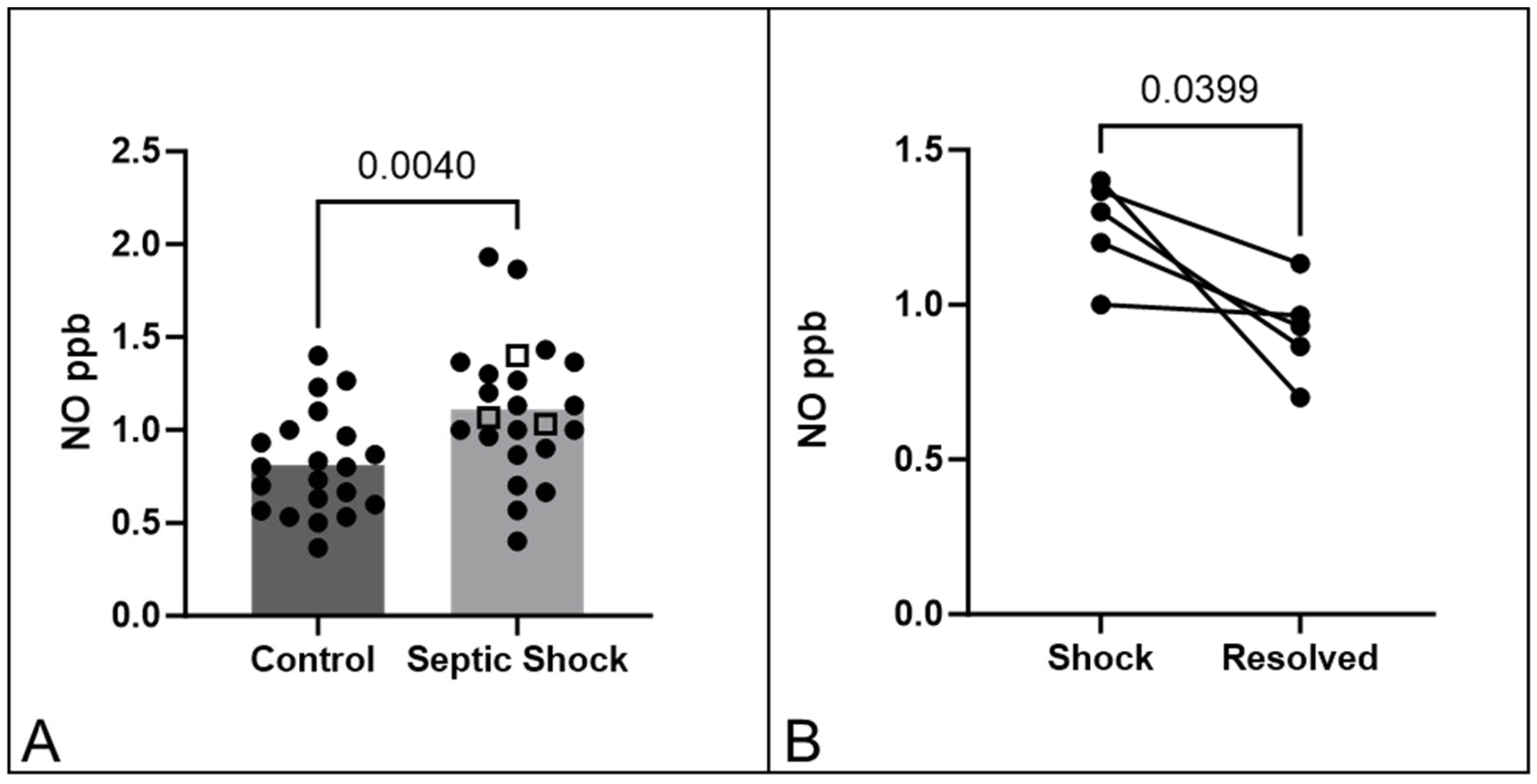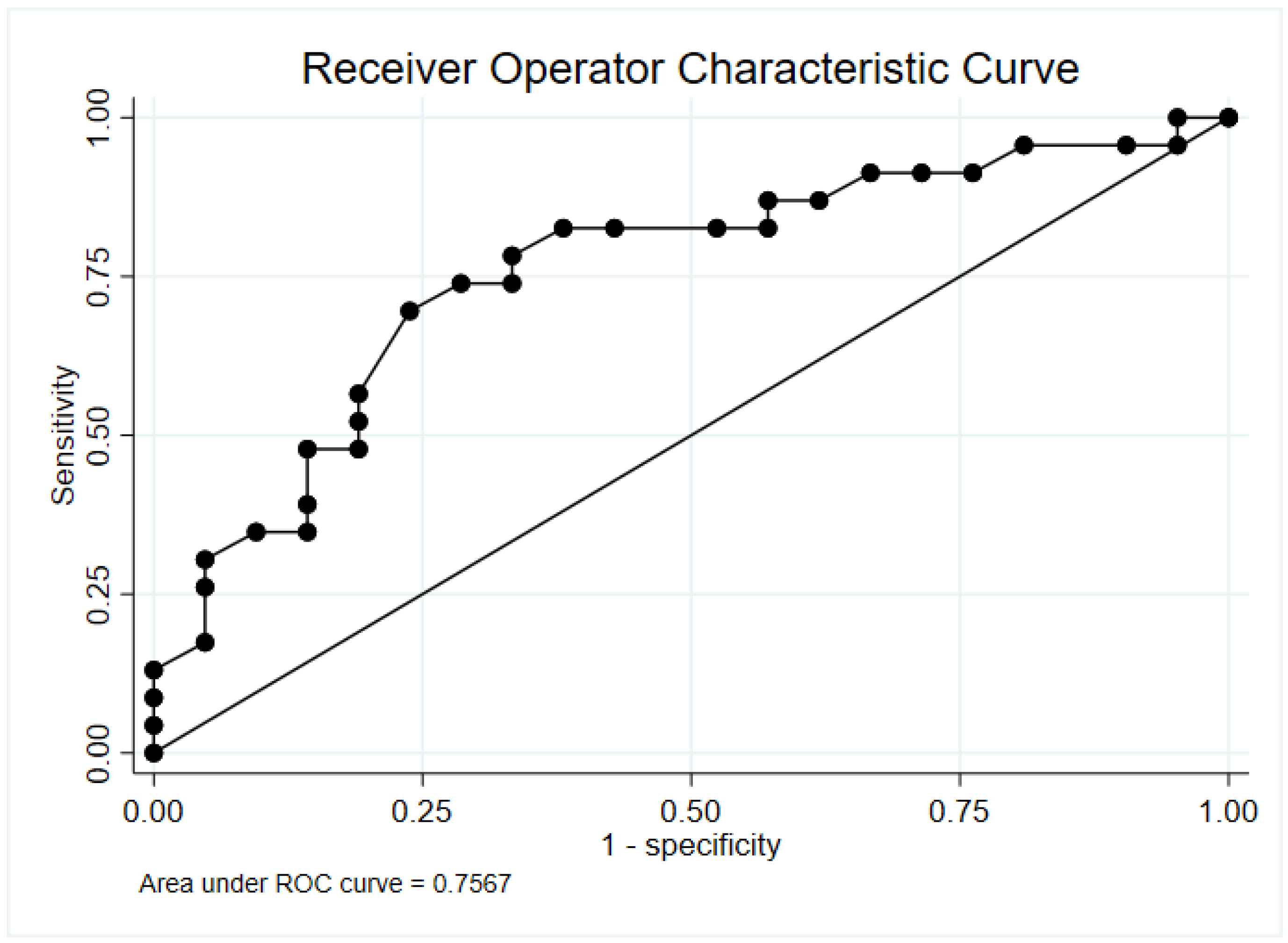In Vivo Analysis of Tissue S-Nitrosothiols in Pediatric Sepsis
Abstract
1. Introduction
2. Materials and Methods
3. Results
3.1. S-Nitrosothiol Levels Stratified by Case or Control
3.2. Determination of Abnormal Photolysis Measurement
3.3. Association of S-Nitrosothiol Levels with Length of Stay
3.4. Association of S-Nitrosothiol Levels with MODS and ARDS Development
3.5. Correlations of S-Nitrosothiol Levels with Sepsis Biomarkers
4. Discussion
5. Conclusions
Supplementary Materials
Author Contributions
Funding
Institutional Review Board Statement
Informed Consent Statement
Data Availability Statement
Conflicts of Interest
References
- Rudd, K.E.; Johnson, S.C.; Agesa, K.M.; Shackelford, K.A.; Tsoi, D.; Kievlan, D.R.; Colombara, D.V.; Ikuta, K.S.; Kissoon, N.; Finfer, S.; et al. Global, regional, and national sepsis incidence and mortality, 1990–2017: Analysis for the Global Burden of Disease Study. Lancet 2020, 395, 200–211. [Google Scholar] [CrossRef]
- Dugani, S.; Veillard, J.; Kissoon, N. Reducing the global burden of sepsis. CMAJ 2017, 189, E2–E3. [Google Scholar] [CrossRef][Green Version]
- Fleischmann-Struzek, C.; Goldfarb, D.M.; Schlattmann, P.; Schlapbach, L.J.; Reinhart, K.; Kissoon, N. The global burden of paediatric and neonatal sepsis: A systematic review. Lancet Respir. Med. 2018, 6, 223–230. [Google Scholar] [CrossRef]
- Coletta, C.; Modis, K.; Olah, G.; Brunyanszki, A.; Herzig, D.S.; Sherwood, E.R.; Ungvari, Z.; Szabo, C. Endothelial dysfunction is a potential contributor to multiple organ failure and mortality in aged mice subjected to septic shock: Preclinical studies in a murine model of cecal ligation and puncture. Crit. Care 2014, 18, 511. [Google Scholar] [CrossRef]
- Lee, W.L.; Liles, W.C. Endothelial activation, dysfunction and permeability during severe infections. Curr. Opin. Hematol. 2011, 18, 191–196. [Google Scholar] [CrossRef]
- Neri, M.; Riezzo, I.; Pomara, C.; Schiavone, S.; Turillazzi, E. Oxidative-Nitrosative Stress and Myocardial Dysfunctions in Sepsis: Evidence from the Literature and Postmortem Observations. Mediat. Inflamm. 2016, 2016, 3423450. [Google Scholar] [CrossRef] [PubMed]
- Kumar, S.; Gupta, E.; Srivastava, V.K.; Kaushik, S.; Saxena, J.; Goyal, L.K.; Mehta, S.; Jyoti, A. Nitrosative stress and cytokines are linked with the severity of sepsis and organ dysfunction. Br. J. Biomed. Sci. 2019, 76, 29–34. [Google Scholar] [CrossRef] [PubMed]
- Chelkeba, L.; Ahmadi, A.; Abdollahi, M.; Najafi, A.; Ghadimi, M.H.; Mosaed, R.; Mojtahedzadeh, M. The effect of parenteral selenium on outcomes of mechanically ventilated patients following sepsis: A prospective randomized clinical trial. Ann. Intensive Care 2015, 5, 29. [Google Scholar] [CrossRef] [PubMed]
- Lopez, A.; Lorente, J.A.; Steingrub, J.; Bakker, J.; McLuckie, A.; Willatts, S.; Brockway, M.; Anzueto, A.; Holzapfel, L.; Breen, D.; et al. Multiple-center, randomized, placebo-controlled, double-blind study of the nitric oxide synthase inhibitor 546C88: Effect on survival in patients with septic shock. Crit. Care Med. 2004, 32, 21–30. [Google Scholar] [CrossRef] [PubMed]
- Pascual-Ramirez, J.; Koutrouvelis, A. The nitric oxide pathway antagonists in septic shock: Meta-analysis of controlled clinical trials. J. Crit. Care 2019, 51, 34–38. [Google Scholar] [CrossRef] [PubMed]
- Gaston, B.; Singel, D.; Doctor, A.; Stamler, J.S. S-nitrosothiol signaling in respiratory biology. Am. J. Respir. Crit. Care Med. 2006, 173, 1186–1193. [Google Scholar] [CrossRef]
- Haldar, S.M.; Stamler, J.S. S-nitrosylation: Integrator of cardiovascular performance and oxygen delivery. J. Clin. Investig. 2013, 123, 101–110. [Google Scholar] [CrossRef] [PubMed]
- Marozkina, N.V.; Gaston, B. Nitrogen chemistry and lung physiology. Annu. Rev. Physiol. 2015, 77, 431–452. [Google Scholar] [CrossRef]
- Singel, D.J.; Stamler, J.S. Blood traffic control. Nature 2004, 430, 297. [Google Scholar] [CrossRef] [PubMed]
- Stamler, J.S.; Jia, L.; Eu, J.P.; McMahon, T.J.; Demchenko, I.T.; Bonaventura, J.; Gernert, K.; Piantadosi, C.A. Blood flow regulation by S-nitrosohemoglobin in the physiological oxygen gradient. Science 1997, 276, 2034–2037. [Google Scholar] [CrossRef]
- Inoue, K.; Akaike, T.; Miyamoto, Y.; Okamoto, T.; Sawa, T.; Otagiri, M.; Suzuki, S.; Yoshimura, T.; Maeda, H. Nitrosothiol formation catalyzed by ceruloplasmin. Implication for cytoprotective mechanism in vivo. J. Biol. Chem. 1999, 274, 27069–27075. [Google Scholar] [CrossRef]
- Doctor, A.; Platt, R.; Sheram, M.L.; Eischeid, A.; McMahon, T.; Maxey, T.; Doherty, J.; Axelrod, M.; Kline, J.; Gurka, M.; et al. Hemoglobin conformation couples erythrocyte S-nitrosothiol content to O2 gradients. Proc. Natl. Acad. Sci. USA 2005, 102, 5709–5714. [Google Scholar] [CrossRef]
- Gaston, B.; Smith, L.; Bosch, J.; Seckler, J.; Kunze, D.; Kiselar, J.; Marozkina, N.; Hodges, C.A.; Wintrobe, P.; McGee, K.; et al. Voltage-gated potassium channel proteins and stereoselective S-nitroso-l-cysteine signaling. JCI Insight 2020, 5, e134174. [Google Scholar] [CrossRef] [PubMed]
- Gaston, B.; Reilly, J.; Drazen, J.M.; Fackler, J.; Ramdev, P.; Arnelle, D.; Mullins, M.E.; Sugarbaker, D.J.; Chee, C.; Singel, D.J.; et al. Endogenous nitrogen oxides and bronchodilator S-nitrosothiols in human airways. Proc. Natl. Acad. Sci. USA 1993, 90, 10957–10961. [Google Scholar] [CrossRef]
- Neidigh, N.; Alexander, A.; van Emmerik, P.; Higgs, A.; Plack, L.; Clem, C.; Cater, D.; Marozkina, N.; Gaston, B. Photolytic Measurement of Tissue S-Nitrosothiols in Rats and Humans In Vivo. Molecules 2022, 27, 1294. [Google Scholar] [CrossRef]
- Gaies, M.G.; Gurney, J.G.; Yen, A.H.; Napoli, M.L.; Gajarski, R.J.; Ohye, R.G.; Charpie, J.R.; Hirsch, J.C. Vasoactive-inotropic score as a predictor of morbidity and mortality in infants after cardiopulmonary bypass. Pediatr. Crit. Care Med. 2010, 11, 234–238. [Google Scholar] [CrossRef]
- Wernovsky, G.; Wypij, D.; Jonas, R.A.; Mayer, J.E., Jr.; Hanley, F.L.; Hickey, P.R.; Walsh, A.Z.; Chang, A.C.; Castaneda, A.R.; Newburger, J.W.; et al. Postoperative course and hemodynamic profile after the arterial switch operation in neonates and infants. A comparison of low-flow cardiopulmonary bypass and circulatory arrest. Circulation 1995, 92, 2226–2235. [Google Scholar] [CrossRef] [PubMed]
- Emeriaud, G.; Lopez-Fernandez, Y.M.; Iyer, N.P.; Bembea, M.M.; Agulnik, A.; Barbaro, R.P.; Baudin, F.; Bhalla, A.; Brunow de Carvalho, W.; Carroll, C.L.; et al. Executive Summary of the Second International Guidelines for the Diagnosis and Management of Pediatric Acute Respiratory Distress Syndrome (PALICC-2). Pediatr. Crit. Care Med. 2023, 24, 143–168. [Google Scholar] [CrossRef] [PubMed]
- Goldstein, B.; Giroir, B.; Randolph, A.; International Consensus Conference on Pediatric, S. International pediatric sepsis consensus conference: Definitions for sepsis and organ dysfunction in pediatrics. Pediatr. Crit. Care Med. 2005, 6, 2–8. [Google Scholar] [CrossRef]
- Schisterman, E.F.; Perkins, N.J.; Liu, A.; Bondell, H. Optimal cut-point and its corresponding Youden Index to discriminate individuals using pooled blood samples. Epidemiology 2005, 16, 73–81. [Google Scholar] [CrossRef]
- StataCorp. Stata Statistical Software: Release 17; StataCorp LLC: College Station, TX, USA, 2021. [Google Scholar]
- Jourd’heuil, D.; Gray, L.; Grisham, M.B. S-nitrosothiol formation in blood of lipopolysaccharide-treated rats. Biochem. Biophys. Res. Commun. 2000, 273, 22–26. [Google Scholar] [CrossRef]
- Liu, L.; Yan, Y.; Zeng, M.; Zhang, J.; Hanes, M.A.; Ahearn, G.; McMahon, T.J.; Dickfeld, T.; Marshall, H.E.; Que, L.G.; et al. Essential roles of S-nitrosothiols in vascular homeostasis and endotoxic shock. Cell 2004, 116, 617–628. [Google Scholar] [CrossRef]
- De Groote, M.A.; Testerman, T.; Xu, Y.; Stauffer, G.; Fang, F.C. Homocysteine antagonism of nitric oxide-related cytostasis in Salmonella typhimurium. Science 1996, 272, 414–417. [Google Scholar] [CrossRef] [PubMed]
- de Jesus-Berrios, M.; Liu, L.; Nussbaum, J.C.; Cox, G.M.; Stamler, J.S.; Heitman, J. Enzymes that counteract nitrosative stress promote fungal virulence. Curr. Biol. 2003, 13, 1963–1968. [Google Scholar] [CrossRef]
- MacMicking, J.D.; North, R.J.; LaCourse, R.; Mudgett, J.S.; Shah, S.K.; Nathan, C.F. Identification of nitric oxide synthase as a protective locus against tuberculosis. Proc. Natl. Acad. Sci. USA 1997, 94, 5243–5248. [Google Scholar] [CrossRef]
- McMahon, T.J.; Moon, R.E.; Luschinger, B.P.; Carraway, M.S.; Stone, A.E.; Stolp, B.W.; Gow, A.J.; Pawloski, J.R.; Watke, P.; Singel, D.J.; et al. Nitric oxide in the human respiratory cycle. Nat. Med. 2002, 8, 711–717. [Google Scholar] [CrossRef] [PubMed]
- Pawloski, J.R.; Hess, D.T.; Stamler, J.S. Export by red blood cells of nitric oxide bioactivity. Nature 2001, 409, 622–626. [Google Scholar] [CrossRef] [PubMed]
- Jia, L.; Bonaventura, C.; Bonaventura, J.; Stamler, J.S. S-nitrosohaemoglobin: A dynamic activity of blood involved in vascular control. Nature 1996, 380, 221–226. [Google Scholar] [CrossRef] [PubMed]


| Variable | Control (n = 21) | Sepsis (n = 23) | p-Value |
|---|---|---|---|
| Age | 5 (0, 9) | 11 (6, 16) | 0.012 |
| BMI | 16.8 (15.8, 19.2) | 18.1 (14.5, 24.5) | 0.805 |
| Gender | 0.919 | ||
| Female | 7 (33.3%) | 8 (34.8%) | |
| Male | 14 (66.7%) | 15 (65.2%) | |
| Ethnicity | 0.999 | ||
| Hispanic | 0 (0.0%) | 1 (4.4%) | |
| Non-Hispanic | 21 (100.0%) | 22 (95.7%) | |
| Race | 0.895 | ||
| Asian | 1 (4.8%) | 0 (0.0%) | |
| Black | 2 (9.5%) | 2 (8.7%) | |
| Unknown | 0 (0.0%) | 1 (4.4%) | |
| White | 14 (85.7%) | 20 (87.0%) | |
| Presence of Comorbidities | 7 (33.3%) | 20 (87.0%) | <0.001 |
| PELOD 1 | 0 (0, 0) | 12 (11, 21) | <0.001 |
| Statistical Measures | Photolytic Measurement ≥ 1 ppb |
|---|---|
| Sensitivity | 0.70 |
| Specificity | 0.76 |
| Area under ROC curve | 0.73 |
| Variable | Normal Photolytic Reading (<1 ppb) | Abnormal Photolytic Reading (≥1 ppb) | p-Value |
|---|---|---|---|
| PELOD | 0.5 (0, 12) | 12 (10, 21) | 0.008 |
| Vasoactive Inotrope Score | 0 (0, 6) | 8 (2, 15) | 0.002 |
| Oxygenation Index | 0 (0, 0) | 2 (0, 10) | 0.011 |
| ARDS Development | 4 (21.1%) | 8 (42.1%) | 0.163 |
| MODS Development | 7 (36.8%) | 15 (79.0%) | 0.020 |
| Number of Dysfunctional Organs | 0 (0, 2) | 2 (0, 3) | 0.008 |
| 28-Day Outcomes | Beta-Coefficient | 95% Confidence Interval | p-Value |
| Ventilator-free days | −5.0 | −9.8 to −0.2 | 0.043 |
| Vasoactive-free days | −4.6 | −8.6 to −0.5 | 0.027 |
| ICU-free days | −2.9 | −10.0 to 4.2 | 0.408 |
| Hospital-free days | −7.0 | −13.4 to −0.5 | 0.035 |
Disclaimer/Publisher’s Note: The statements, opinions and data contained in all publications are solely those of the individual author(s) and contributor(s) and not of MDPI and/or the editor(s). MDPI and/or the editor(s) disclaim responsibility for any injury to people or property resulting from any ideas, methods, instructions or products referred to in the content. |
© 2024 by the authors. Licensee MDPI, Basel, Switzerland. This article is an open access article distributed under the terms and conditions of the Creative Commons Attribution (CC BY) license (https://creativecommons.org/licenses/by/4.0/).
Share and Cite
Cater, D.T.; Clem, C.; Marozkina, N.; Gaston, B. In Vivo Analysis of Tissue S-Nitrosothiols in Pediatric Sepsis. Antioxidants 2024, 13, 263. https://doi.org/10.3390/antiox13030263
Cater DT, Clem C, Marozkina N, Gaston B. In Vivo Analysis of Tissue S-Nitrosothiols in Pediatric Sepsis. Antioxidants. 2024; 13(3):263. https://doi.org/10.3390/antiox13030263
Chicago/Turabian StyleCater, Daniel T., Charles Clem, Nadzeya Marozkina, and Benjamin Gaston. 2024. "In Vivo Analysis of Tissue S-Nitrosothiols in Pediatric Sepsis" Antioxidants 13, no. 3: 263. https://doi.org/10.3390/antiox13030263
APA StyleCater, D. T., Clem, C., Marozkina, N., & Gaston, B. (2024). In Vivo Analysis of Tissue S-Nitrosothiols in Pediatric Sepsis. Antioxidants, 13(3), 263. https://doi.org/10.3390/antiox13030263







